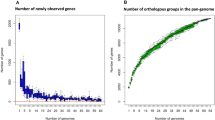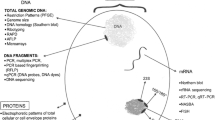Abstract
Listeria monocytogenes exhibits symbiotic codependence with the dominant commensal bacteria, which may help it avoid being removed or inactivated by disinfectants in local environments. In this study, we investigated L. monocytogenes-positive biofilms at food production facilities, and the dominant bacterial species of the biofilms were identified to determine the properties of the microbiological background. For this purpose, the ISO 11290 method was used for the detection and isolation of L. monocytogenes, and the species were further identified based on 16S rRNA and hly genes. 16S rRNA gene-based cloning, terminal restriction fragment length polymorphism, and denaturing gradient gel electrophoresis were combined to evaluate the dominant bacteria of the drain biofilms. Out of 100 drain samples, 8 were naturally contaminated with L. monocytogenes. Three molecular methods consistently showed that Pseudomonas psychrophila, Pseudomonas sp., and Klebsiella oxytoca were dominant species in 3Q, 5Q, and 6Q samples; Aeromonas hydrophila and Klebsiella sp. were significantly dominant in 1-2, 1-3, and 3-2 samples; A. hydrophila and K. oxytoca were dominant in the 2-3 sample; and A. hydrophila and Pseudomonas sp. were prominent in the 3-3 sample. Different biofilms from the same plant shared common bands, suggesting that similar bacteria can be found and can be dominant in different biofilms. This study provides a better understanding of the dominant compositions in these bacterial communities. Further studies to determine the mechanism of co-culture with L. monocytogenes will be of critical importance in predicting effective disinfection strategies.



Similar content being viewed by others
References
Arihara K, Cassens RG, Luchansky JB (1993) Characterization of bacteriocins from Enterococcus faecium with activity against Listeria monocytogenes. Int J Food Microbiol 19:123–134. doi:10.1016/0168-1605(93)90178-J
Becker B, Schuler S, Lohneis M, Sabrowski A, Curtis G, Holzapfel W (2006) Comparison of two chromogenic media for the detection of Listeria monocytogenes with the plating media recommended by EN/DIN 11290-1. Int J Food Microbiol 109:127–131. doi:10.1016/j.ijfoodmicro.2006.01.030
Berrang ME, Frank JF (2012) Generation of airborne Listeria innocua from model floor drains. J Food Prot 75:1328–1331. doi:10.4315/0362-028X.JFP-12-021
Bridier A, Briandet R, Thomas V, Dubois-Brissonnet F (2011) Resistance of bacterial biofilms to disinfectants: a review. Biofouling 27:1017–1032. doi:10.1080/08927014.2011.626899
Chorianopoulos NG, Giaouris ED, Skandamis PN, Haroutounian SA, Nychas G-E (2008) Disinfectant test against monoculture and mixedculture biofilms composed of technological, spoilage and pathogenic bacteria: bactericidal effect of essential oil and hydrosol of Satureja thymbra and comparison with standard acid-base sanitizers. J Appl Microbiol 104:1586–1596. doi:10.1111/j.1365-2672.2007.03694.x
Costerton JW, Lewandowski Z, Caldwell DE, Korber DR, Lappin-Scott HM (1995) Microbial biofilms. Annu Rev Microbiol 49:711–745. doi:10.1146/annurev.mi.49.100195.003431
Dar SA, Yao L, Van Dongen U, Kuenen JG, Muyzer G (2007) Analysis of diversity and activity of sulfate-reducing bacterial communities in sulfidogenic bioreactors using 16S rRNA and dsrB genes as molecular markers. Appl Environ Microb 73:594–604. doi:10.1128/AEM.01875-06
Elias S, Banin E (2012) Multi-species biofilms: living with friendly neighbors. FEMS Microbiol Rev 36:990–1004. doi:10.1111/j.1574-6976.2012.00325.x
González D, Vitas AI, Díez-Leturia M, García-Jalón I (2013) Listeria monocytogenes and ready-to-eat seafood in Spain: study of prevalence and temperatures at retail. Food Microbiol 36:374–378. doi:10.1016/j.fm.2013.06.023
Good IJ (1953) The population frequencies of species and the estimation of population parameters. Biometrika 40:237–264. doi:10.2307/2333344
Grim CJ, Kozlova EV, Sha J, Fitts EC, van Lier CJ, Kirtley ML, Joseph SJ, Read TD, Burd EM, Tall BD, Joseph SW, Horneman AJ, Chopra AK, Shak JR (2013) Characterization of Aeromonas hydrophila wound pathotypes by comparative genomic and functional analyses of virulence genes. mBio 4:e00064–13. doi:10.1128/mBio.00064-13
Gudbjornsdóttir B, Suihko ML, Gustavsson P, Thorkelsson G, Salo S, Sjoberg AM, Niclasen O, Bredholt S (2004) The incidence of L. monocytogenes in meat, poultry and seafood plants in the Nordic countries. Food Microbiol 21:217–225. doi:10.1016/S0740-0020(03)00012-1
Habimana O, Guillier L, Kulakauskas S, Briandet R (2011) Spatial competition with Lactococcus lactis in mixed-species continuous-flow biofilms inhibits Listeria monocytogenes growth. Biofouling 27:1065–1072. doi:10.1080/08927014.2011.626124
Habimana O, Heir E, Langsrud S, Asli AW, Møretrø T (2010) Enhanced surface colonization by Escherichia coli O157:H7 in biofilms formed by an Acinetobacter calcoaceticus isolate from meat-processing environments. Appl Environ Microbiol 76:4557–4559. doi:10.1128/AEM.02707-09
Habimana O, Meyrand M, Meylheuc T, Kulakauskas S, Briandet R (2009) Genetic features of resident biofilms determine attachment of L. monocytogenes. Appl Environ Microbiol 75:7814–7821. doi:10.1128/AEM.01333-09
Hartmann M, Widmer F (2006) Community structure analyses are more sensitive to differences in soil bacterial communities than anonymous diversity indices. Appl Environ Microbiol 72:7804–7812. doi:10.1128/AEM.01464-06
Hoelzer K, Saunders BD, Sanchez MD, Olsen PT, Pickett MM, Mangione KJ, Rice DH, Corby J, Stich S, Fortes ED, Roof SE, Grohn YT, Wiedmann M, Oliver HF (2011) Prevalence, distribution, and diversity of L. monocytogenes in retail environments, focusing on small establishments with a history of failed inspections. J Food Protect 74:1083–1095. doi:10.4315/0362-028X.JFP-10-567
Hossain MJ, Sun D, McGarey DJ, Wrenn S, Alexander LM, Martino ME, Xing Y, Terhune JS, Liles MR (2014) An Asian origin of virulent Aeromonas hydrophila responsible for disease epidemics in United States-farmed catfish. mBio 5:e00848–14. doi:10.1128/mBio.00848-14
Huber T, Faulkner G, Hugenholtz P (2004) Bellerophon: a program to detect chimeric sequences in multiple sequence alignments. Bioinformatics 20:2317–2319. doi:10.1093/bioinformatics/bth226
Hughes JB, Hellmann JJ, Ricketts TH, Bohannan BJ (2001) Counting the uncountable: statistical approaches to estimating microbial diversity. Appl Environ Microbiol 67:4399–4406. doi:10.1128/AEM.67.10.4399-4406.2001
Ibarbalz FM, Pérez MV, Figuerola ELM, Erijman L (2014) The bias associated with amplicon sequencing does not affect the quantitative assessment of bacterial community dynamics. PLOS One 9:e99722. doi:10.1371/journal.pone.0099722
Iwamoto M, Ayers T, Mahon BE, Swerdlow DL (2010) Epidemiology of seafood-associated infections in the United States. Clin Microbiol Rev 23:399–411. doi:10.1128/CMR.00059-09
Jamali H, Chai LC, Thong KL (2013) Detection and isolation of Listeria spp. and L. monocytogenes in ready-to-eat foods with various selective culture media. Food Control 32:19–24. doi:10.1016/j.foodcont.2012.11.033
Jami M, Ghanbari M, Zunabovic M, Domig KJ, Kneifel W (2014) L. monocytogenes in aquatic food products—a review. Compr Rev Food Sci 13:798–813. doi:10.1111/1541-4337.12092
Janek T, Łukaszewicz M, Krasowska A (2012) Antiadhesive activity of the biosurfactant pseudofactin II secreted by the Arctic bacterium Pseudomonas fluorescens BD5. BMC Microbiol 12:24. doi:10.1186/1471-2180-12-24
Jeong DK, Frank JF (1994) Growth of Listeria monocytogenes at 21°C in biofilms with microorganisms isolated from meat and dairy processing environments. Lebensm Wiss Technol 27:415–424. doi:10.1006/fstl.1994.1087
Junier P, Junier T, Witzel K-P (2008) TRiFLe, a program for in silico terminal restriction fragment length polymorphism analysis with user-defined sequence sets. Appl Environ Microbiol 74:6452–6456. doi:10.1128/AEM.01394-08
Kaplan CW, Kitts CL (2003) Variation between observed and true terminal restriction fragment length is dependent on true TRF length and purine content. J Microbiol Meth 54:121–125. doi:10.1016/S0167-7012(03)00003-4
Koch J, Dworak R, Prager R, Becker B, Brockmann S, Wicke A, Wichmann Schauer H, Hof H, Werber D, Stark K (2010) Large listeriosis outbreak linked to cheese made from pasteurized milk, Germany, 2006–2007. Foodborne Pathog Dis 7:1581–1584. doi:10.1089/fpd.2010.0631
Kostaki M, Chorianopoulos N, Braxou E, Nychas G-J, Giaouris E (2012) Differential biofilm formation and chemical disinfection resistance of sessile cells of Listeria monocytogenes strains under monospecies and dual-species (with Salmonella enterica) conditions. Appl Environ Microbiol 78:2586–2595. doi:10.1128/AEM.07099-11
Laksanalamai P, Joseph LA, Silk BJ, Burall LS, Tarr CL, Gerner-Smidt P, Datta AR (2012) Genomic characterization of L. monocytogenes strains involved in a multistate listeriosis outbreak associated with cantaloupe in US. PLoS One 7:e42448. doi:10.1371/journal.pone.0042448
Lee DG, Lee JH, Kim SJ (2005) Diversity and dynamics of bacterial species in a biofilm at the end of the Seoul water distribution system. World J Microb Biot 21:155–162. doi:10.1007/s11274-004-2890-0
Lee OO, Wang Y, Yang JK, Lafi F, Al-Suwailem A, Qian PY (2011) Pyrosequencing reveals highly diverse and speciesspecific microbial communities in sponges from the Red Sea. ISME J 5:650–664. doi:10.1038/ismej.2010.165
Mathieu L, Bouteleux C, Fass S, Angel E, Block JC (2009) Reversible shift in the alpha-, beta- and gamma-proteobacteria populations of drinking water biofilms during discontinuous chlorination. Water Res 43:3375–3386. doi:10.1016/j.watres.2009.05.005
McGinnis S, Madden TL (2004) BLAST: at the core of a powerful and diverse set of sequence analysis tools. Nucleic Acids Res 32:20–25. doi:10.1093/nar/gkh435
Muyzer G, Smalla K (1998) Application of denaturing gradient gel electrophoresis (DGGE) and temperature gradient gel electrophoresis (TGGE) in microbial ecology. Anton Leeuw Int J G 73:127–141. doi:10.1023/A:1000669317571
Nilsson RE, Ross T, Bowman JP (2011) Variability in biofilm production by Listeria monocytogenes correlated to strain origin and growth conditions. Int J Food Microbiol 150:14–24. doi:10.1016/j.ijfoodmicro.2011.07.012
Nunan N, Daniell TJ, Singh BK, Papert A, McNicol JW, Prosser JI (2005) Links between plant and rhizoplane bacterial communities in grassland soils, characterized using molecular techniques. Appl Environ Microbiol 71:6784–6792. doi:10.1128/AEM.71.11.6784-6792.2005
Nyenje ME, Odjadjare CE, Tanih NF, Green E, Ndip RN (2012) Foodborne pathogens recovered from ready-to-eat foods from roadside cafeterias and retail outlets in Alice, Eastern Cape Province, South Africa: public health implications. Int J Environ Res Public Health 9:2608–2619. doi:10.3390/ijerph9082608
Pagedar A, Singh J, Batish VK (2012) Adaptation to benzalkonium chloride and ciprofloxacin affects biofilm formation potential, efflux pump and haemolysin activity of Escherichia coli of dairy origin. J Dairy Res 79:383–389. doi:10.1017/S0022029912000295
Papadopoulou OS, Chorianopoulos NG, Gkana EN, Grounta AV, Koutsoumanis KP, Nychas G-E (2012) Transfer of foodborne pathogenic bacteria to non-inoculated beef fillets through meat mincing machine. Meat Sci 90:865–869. doi:10.1016/j.meatsci.2011.11.008
Rendueles O, Ghigo JM (2012) Multi-species biofilms: how to avoid unfriendly neighbors. FEMS Microbiol Rev 36:972–989. doi:10.1111/j.1574-6976.2012.00328.x
Russell AD (2001) Mechanisms of bacterial insusceptibility to biocides. Am J Infect Control 29:259–261. doi:10.1067/mic.2001.115671
Saá Ibusquiza PS, Herrera JJ, Cabo ML (2011) Resistance to benzalkonium chloride, peracetic acid and nisin during formation of mature biofilms by L. monocytogenes. Food Microbiol 28:418–425. doi:10.1016/j.fm.2010.09.014
Sanchez JI, Rossetti L, Martinez B, Rodriguez A, Giraffa G (2006) Application of reverse transcriptase PCR-based T-RFLP to perform semi-quantitative analysis of metabolically active bacteria in dairy fermentations. J Microbiol Meth 65:268–277. doi:10.1016/j.mimet.2005.07.018
Vallaeys T, Topp E, Muyzer G, Macheret V, Laguerre G, Rigeaud A, Soulas G (1997) Evaluation of denaturing gradient gel electrophoresis in the detection of 16S rDNA sequence variation in rhizobia and methanotrophs. FEMS Microbiol Ecol 24:279–285. doi:10.1111/j.1574-6941.1997.tb00445.x
Wang Q, Garrity GM, Tiedje JM, Cole JR (2007) Naive Bayesian classifier for rapid assignment of rRNA sequences into the new bacterial taxonomy. Appl Environ Microbiol 73:5261–5267. doi:10.1128/AEM.00062-07
Zhang M, Liu W, Nie X, Li C, Gu J, Zhang C (2012) Molecular analysis of bacterial communities in biofilms of a drinking water clearwell. Microbes Environ 27:443–448. doi:10.1264/jsme2.ME12035
Zhao T, Podtburg TC, Zhao P, Chen D, Baker DA, Cords B, Doyle MP (2013) Reduction by competitive bacteria of L. monocytogenes in biofilms and Listeria bacteria in floor drains in a ready-to-eat poultry processing plant. J Food Protect 76:601–607. doi:10.4315/0362-028X.JFP-12-323
Acknowledgments
This study was supported by the National Natural Science Foundation of China (No.31301480 and No. 31300804).
Author information
Authors and Affiliations
Corresponding author
Ethics declarations
This study was funded by the National Natural Science Foundation of China (No.31301480 and No. 31300804). The authors declare that they have no conflict of interest. This article does not contain any studies with human participants or animals performed by any of the authors. Informed consent was obtained from all individual participants included in the study.
Additional information
Yanlan Liu and Hongmei Zhang contributed equally to this work.
Rights and permissions
About this article
Cite this article
Liu, Y., Zhang, H., Wu, C. et al. Molecular analysis of dominant species in Listeria monocytogenes-positive biofilms in the drains of food processing facilities. Appl Microbiol Biotechnol 100, 3165–3175 (2016). https://doi.org/10.1007/s00253-015-7203-z
Received:
Revised:
Accepted:
Published:
Issue Date:
DOI: https://doi.org/10.1007/s00253-015-7203-z




